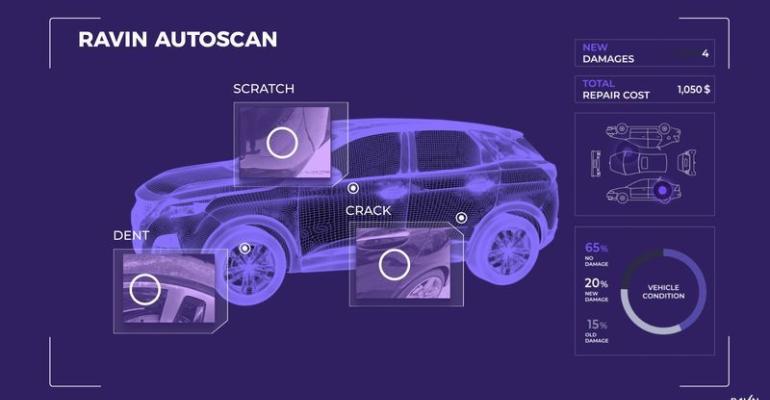When someone buys a car, registers a car or sells a used car to someone else, at least three people are involved: the buyer, the seller – and the inspector. Those individuals are crucial for all car transactions, whether to ensure that the vehicle is roadworthy, to fulfill government mandates for safety inspections or to just give buyers confidence that they’re paying a fair price.
Increasingly, inspections are being performed by remote systems, where instead of physically scouring over individual vehicles, inspectors remotely analyze images and data about vehicles to determine if they are roadworthy, if they have sustained damage in an accident, if they are worth the listed price or if they have some hidden engine issues. And as technology improves – with advanced sensors and imaging systems uploading data and images over near-zero latency communication systems, coupled with next-generation AI and data analysis – the trends that have already made individual, in-person inspections a shrinking industry will continue.
Remote, automated inspections are preferable to in-person inspections for numerous reasons, ranging from increased efficiency and a better customer experience to – of course – lower costs.
Increased Accuracy With Computer Vision
Human inspectors are highly trained, but they are still humans – and humans can, and do, miss things at times. While humans are (at least for now) better at contextual understanding than sensor-based AI analysis systems, there is no question that advanced sensors and imaging systems are better at parsing data, finding flaws and detecting anomalies – all tasks that inspectors are responsible for.
Even now, inspectors use AI-powered systems to check vehicles; the technologies are especially popular at rental car companies, which use them to detect scratches and other subtle damage, creating an objective record about when such damage occurred and that can be used to determine responsibility. But with advanced communication technologies, the same data and images can be uploaded and parsed remotely.
Dealerships, repair shops and even vehicle renters could upload a few images of the vehicle, while vehicle sensors would upload the rest of the needed data – enabling data-analysis systems to quickly and efficiently generate a vehicle condition report. The reports would record physical damage, build a profile of driver behavior, determine the health of an engine or whether it is releasing excessive carbon into the atmosphere, and much more.
A Better Customer Experience With Data
Data is objective; humans are not. When a driver brings a vehicle in for repair, there is often the suspicion that the mechanic – who initially takes on the role of inspector, determining if there is indeed a problem – could “pad” their report to get more money out of the customer. A remote inspection by the garage – where information is uploaded for analysis – can take the edge off the client-mechanic relationship, since the data is not subject to interpretation, making the repair experience less tense for both sides.
As an added benefit, this saves both time and effort, with the mechanic keeping “healthy” vehicles out of the garage, and customers saving time by not taking what could be an unnecessary trip to the garage.
The same holds true for any customer-vendor relationship where either side has reason to suspect their counterpart. Car-rental customers often fear they will get stuck with a repair bill for a previous customer’s damage – while rental firms are concerned that unethical customers will deny damage they caused. Objective, image- and data-based inspections can alleviate that. And if the images are taken automatically when a customer drops off the vehicle, even if the office is closed, or able to be done via mobile phone, the experience will go much more smoothly for them and the company.
Remote inspections also will make online vehicle sales go more smoothly. Online sales became popular during the pandemic and are set to get even stronger over the next several years. Remote inspections will help online buyers of both new and used vehicles efficiently determine that they are getting a safe vehicle – and that the vehicle they are buying is worth the price they are paying, without having to leave their homes.
Saving Money With Remote Inspections
Besides the obvious savings in time and travel that result from replacing in-person inspections with remote inspections, machine vision and data-based inspections save money in other ways. For example, many repair shops and car rental companies use multi-point inspection – deploying several inspectors – to ensure that nobody missed anything.
These multiple inspections can help ensure that vehicles are safe to drive and that no damage, whether internal or external, has been missed – but they run up costs for the company. With a remote inspection system, customers could upload data and images for analysis and come into the garage only if there were indeed a problem – obviating the need for multiple in-person inspections.
 Remote is a hot trend today in many industries – and with today’s technologies, there's no reason vehicle inspection won’t follow. The elements for a fully automated, fully remote vehicle inspection experience – at all levels, from retail to manufacturing to maintenance and repair – are all available, and in place. There’s a reason those vehicle-inspection jobs are disappearing – and everyone involved in vehicle buying, selling, manufacturing and repair will benefit.
Remote is a hot trend today in many industries – and with today’s technologies, there's no reason vehicle inspection won’t follow. The elements for a fully automated, fully remote vehicle inspection experience – at all levels, from retail to manufacturing to maintenance and repair – are all available, and in place. There’s a reason those vehicle-inspection jobs are disappearing – and everyone involved in vehicle buying, selling, manufacturing and repair will benefit.
Neil Alliston (pictured, above left) is executive vice president of product and strategy at Ravin.ai, which makes an AI-powered vehicle inspection platform.





